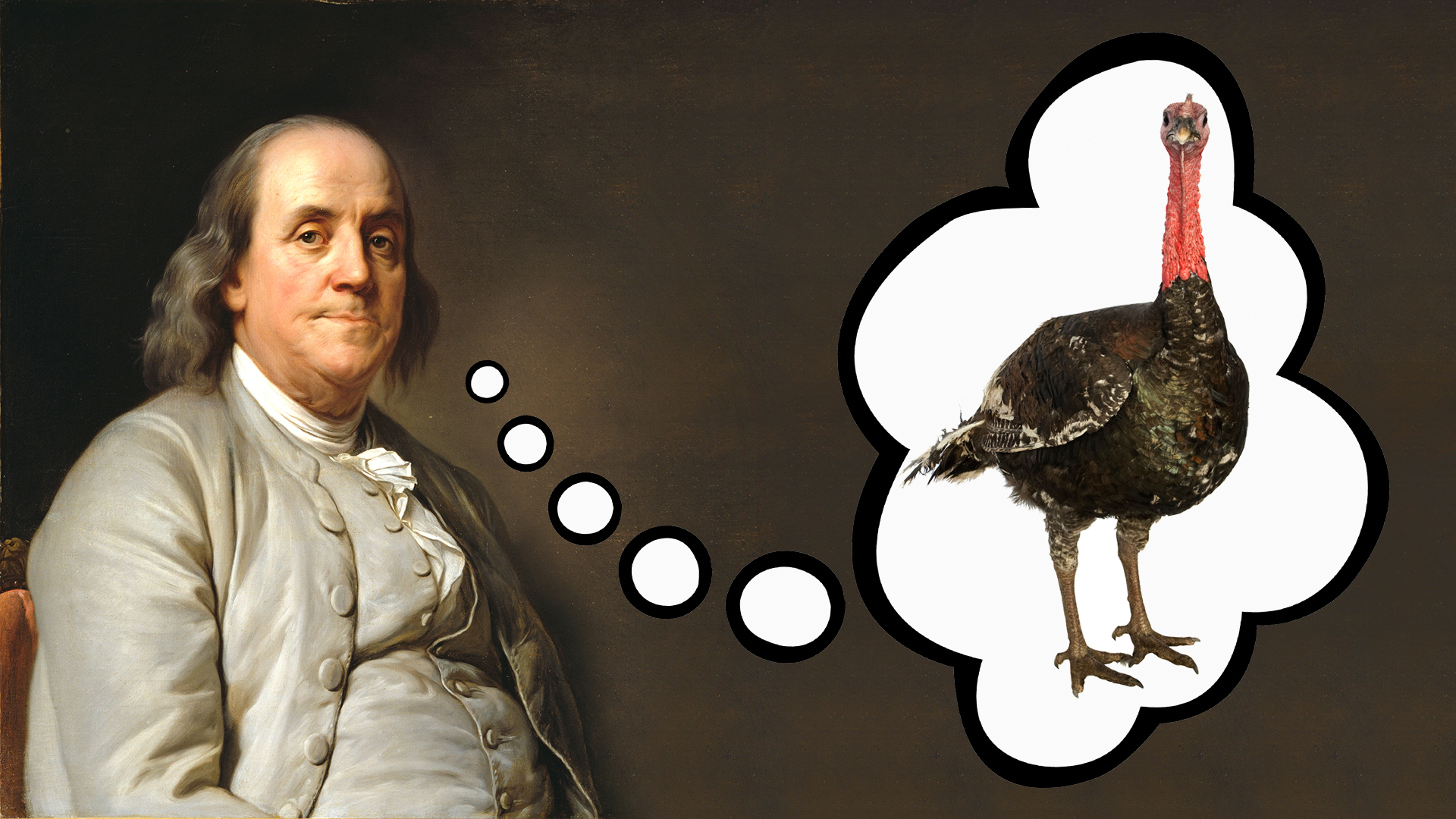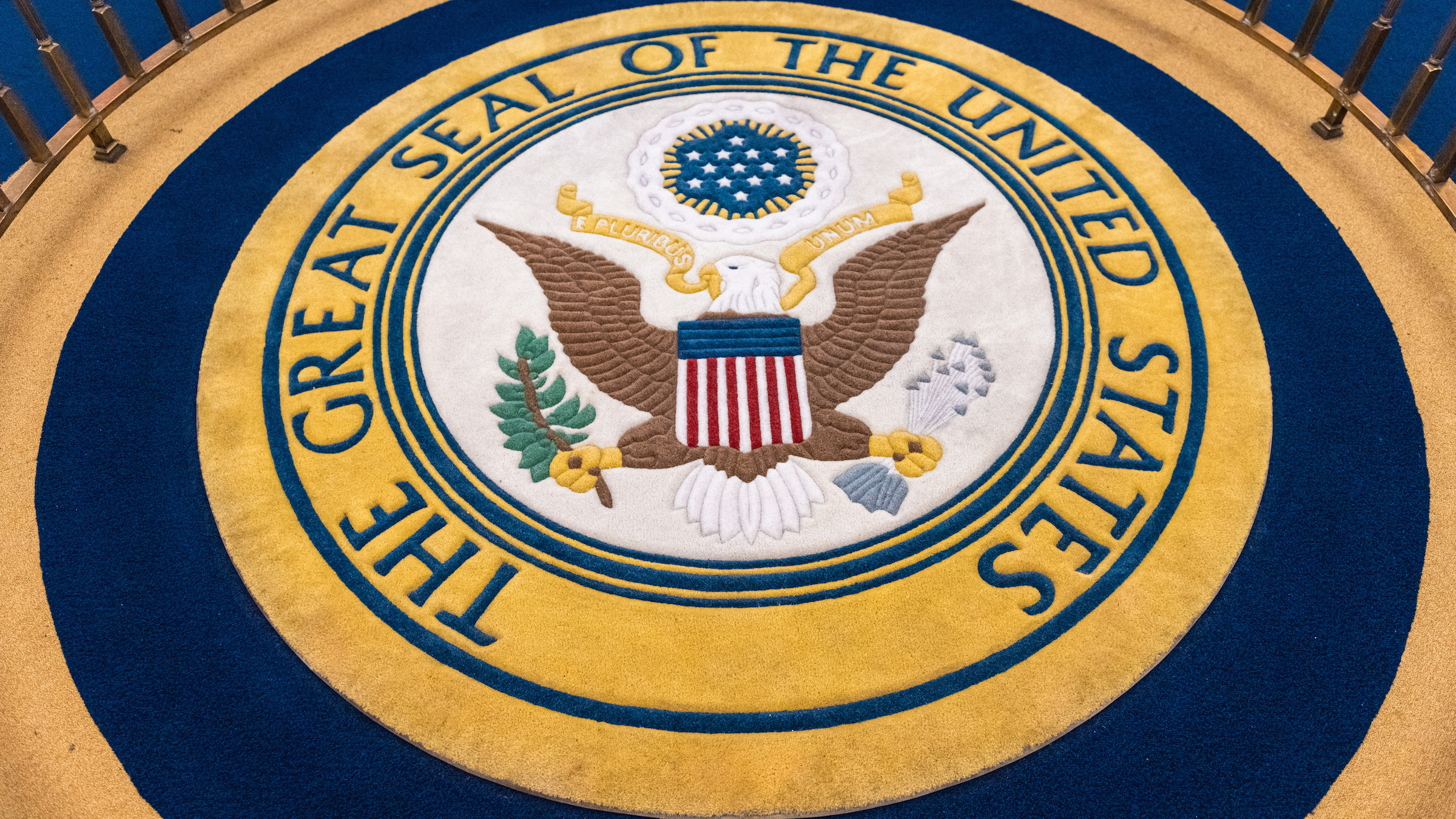Did Benjamin Franklin really want the turkey to be the US national bird?
Probably not. But there's more to the story than meets the eye.

There's a story that Benjamin Franklin thought the turkey should be the national bird instead of the eagle. In a 1784 letter addressed to Sarah, his daughter, Franklin wrote:
"For my own part I wish the bald eagle had not been chosen as the representative of our country. He is a bird of bad moral character. He does not get his living honestly. You may have seen him perched on some dead tree, where, too lazy to fish for himself, he watches the labour of the fishing hawk; and when that diligent bird has at length taken a fish, and is bearing it to his nest for the support of his mate and young ones, the bald eagle pursues him, and takes it from him. . . . the turkey is in comparison a much more respectable bird, and withal a true original native of America."
People often interpret this story to mean that Franklin wanted to replace the eagle on the Great Seal of the United States with a turkey. In a November 1962 cover of "The New Yorker", cartoonist Anatol Kovarsky did as much. But some historians suggest that Franklin wasn't actually serious. "Yeah, he was joking," comments Best Life magazine. Likewise, "The Eagle and the Shield: A History of the Great Seal of the United States" (1976), a book put out by the U.S. State Department and authored by Richard S. Patterson and Richardson Dougall, opines that "Franklin was probably not writing seriously," adding that Franklin had already used the new eagle seal on some of his own publications.
Related: When did the Brits and Yanks become allies again after the Revolutionary War?
So which is it? Did Franklin want the turkey to be our mascot, was he poking fun at the very idea of having a mascot, or was he making fun of something else entirely? These are good questions, given that Franklin actually helped design the very seal that he is allegedly roasting.
Franklin's role in the seal design
The idea of the eagle as America's national bird comes from the eagle's presence on The Great Seal of the United States, also known as the Seal of the United States, according to History.com. On July 4, 1776, the very day that the U.S. declared its independence from Great Britain, the Continental Congress asked Franklin, John Adams and Thomas Jefferson to work as a committee to come up with a seal for the new nation, according to Britannica. Each founder came up with his own proposal, according to a National Archives record. Franklin proposed not a turkey, not an eagle, but this: A scene from Exodus — "Moses standing on the Shore, and extending his Hand over the Sea, thereby causing the same to overwhelm Pharoah … " Franklin wrote in his proposal.
Franklin, Adams and Jefferson consulted with Philadelphia artist Pierre Eugène du Simitière about the design and ultimately chose a design of du Simitière's — still no eagle — for the front of the seal, according to "The Eagle and the Shield." For the back, they proposed using Franklin's Exodus design. The group proposed this double-sided seal design, in the form of a written description, to congress in August 1776, but the legislative body tabled it.
Get the world’s most fascinating discoveries delivered straight to your inbox.
In 1780, the design project passed to a new committee, of which Franklin was not a part. It was Philadelphia lawyer William Barton, who entered the project in 1782, who introduced an eagle into the design, according to History.com. Then Charles Thomson, secretary of congress, made some changes; check out his 1782 design at the National Archives. Two pieces of legislation, one in 1782 and one in 1789, made it official: An eagle was on our seal and thus became our de facto national bird.
Related: Columbus 'discovered' the New World … so why isn't America named after him?
Was Franklin serious?
By the time Franklin wrote to his daughter in 1784, he was no longer part of the seal project. Maybe he was over it and just having a laugh. But not everyone thinks he was joking, exactly. "I don't think Franklin took the idea of a national bird seriously. National birds, national trees, national this and that weren't a regular thing back then," H. W. Brands, author of "The First American: The Life and Times of Benjamin Franklin," (Doubleday, 2000) told Live Science in an email. "But I think he was serious that turkeys had character traits superior to those of eagles."
"The story about Benjamin Franklin wanting the National Bird to be a turkey is just a myth," the Franklin Institute, a science museum and science education center in Philadelphia, writes on its website. But that organization does not say Franklin was joking; it just says that Franklin didn't specifically propose the turkey as the national bird. "Although Benjamin Franklin defended the honor of the turkey against the bald eagle, he did not propose its becoming one of America's most important symbols," the Franklin Institute continues.
Was the letter a joke… about something else?
Commentary accompanying a National Archives transcript of the letter states that Franklin never actually sent the 1784 "turkey" letter to his daughter. Instead, he wrote it as a satire of the Society of the Cincinnati, which was a patriotic organization formed by former Revolutionary War officers, according to Britannica. Group membership was — and still is, according to its current website — open only to male descendants of the Revolutionary War officers, as well as to French officers who fought for America's independence, and their male children through the generations.
"Here BF is lampooning hereditary orders, in this case the Cincinnati, a club of officers from the American Revolution," said Brands, who is also a professor of history at University of Texas at Austin.
The National Archives commentary adds that Franklin never sent the letter to his daughter, with whom he didn't correspond about politics, but did send it to André Morellet, a French economist and thinker, to translate into French. In this way, "Franklin cloaked what was intended to be a public essay in a fictional veneer of privacy," the National Archives commentary said. In other words, Franklin was ribbing the society in a "private" letter that he intended to eventually make public. Morellet advised him not to publish it during his lifetime, and Franklin, who died in 1790, took the advice, according to the National Archives commentary. A partial French translation was published in Paris within months of Franklin's death, and the entire letter was first published in English in 1817.
To pile on the confusion, the letter's tirade against the eagle calls it "by no means a proper emblem for the brave and honest Cincinnati of America." In the commonly-told story of Franklin wanting the turkey to be the national bird, it's often assumed that he's talking about the national seal. But perhaps he likely wasn't; the emblem of the Society of the Cincinnati is also an eagle. It seems, therefore, that Franklin might have been flipping the bird at Cincinnati society's eagle, not the one on the seal he'd helped design. Or maybe, given Franklin's stated opposition to the eagle as "the representative of our country," he was criticizing both eagle symbols, not to mention the bird of prey itself.
So there you have it: Franklin didn't want the turkey to be the U.S. national bird, but rather appears to have used the gobbler as a way to scoff at the Society of the Cincinnati's hereditary traditions and possibly even the idea of honoring the eagle on the national stage.
Originally published on Live Science.

Ashley P. Taylor is a writer based in Brooklyn, New York. As a science writer, she focuses on molecular biology and health, though she enjoys learning about experiments of all kinds. Ashley's work has appeared in Live Science, The New York Times blogs, The Scientist, Yale Medicine and PopularMechanics.com. Ashley studied biology at Oberlin College, worked in several labs and earned a master's degree in science journalism from New York University's Science, Health and Environmental Reporting Program.




